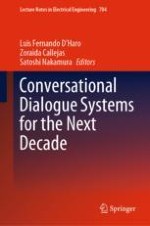2021 | OriginalPaper | Buchkapitel
The Influence of Syntax on the Perception of In-Vehicle Prompts and Driving Performance
verfasst von : Daniela Stier, Ulrich Heid, Patricia Kittel, Maria Schmidt, Wolfgang Minker
Erschienen in: Conversational Dialogue Systems for the Next Decade
Verlag: Springer Singapore
Aktivieren Sie unsere intelligente Suche, um passende Fachinhalte oder Patente zu finden.
Wählen Sie Textabschnitte aus um mit Künstlicher Intelligenz passenden Patente zu finden. powered by
Markieren Sie Textabschnitte, um KI-gestützt weitere passende Inhalte zu finden. powered by
